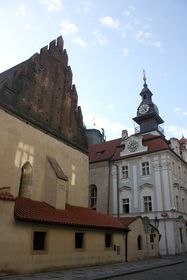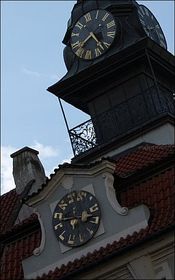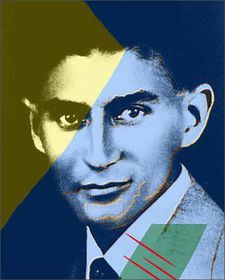Maisel Street 18, Old Town
 Opposite the Old-New Synagogue stands the Jewish Town Hall purchased by the Jewish community in 1577.The Italian master builder Pankraz Roder was said to have been entrusted by the Jewish City Fathers with its rebuilding as well as with the addition of a new town hall synagogue (also called High Synagogue). The money for this construction was given by Mordechai Maisel, a rich banker of the Jewish Quarter and the benefactor of Prague’s Jews. Since the new town hall stood in the immediate neighborhood of the Old-New Synagogue and of the kosher slaughter houses, the actual center of the Jewish City developed in this quarter.
Opposite the Old-New Synagogue stands the Jewish Town Hall purchased by the Jewish community in 1577.The Italian master builder Pankraz Roder was said to have been entrusted by the Jewish City Fathers with its rebuilding as well as with the addition of a new town hall synagogue (also called High Synagogue). The money for this construction was given by Mordechai Maisel, a rich banker of the Jewish Quarter and the benefactor of Prague’s Jews. Since the new town hall stood in the immediate neighborhood of the Old-New Synagogue and of the kosher slaughter houses, the actual center of the Jewish City developed in this quarter.
After Prague was besieged by the Swedes in 1648 the authorities allowed the Jews to build a tower for the town hall in gratitude for their help in the defense of the city. During the great fire in the Old Town in 1682 the town hall was heavily damaged, but was able to be repaired afterward by the architect Paul Ignaz Bayer. Then, Empress Maria Theresia issued an edict banning all Jews from the city and they were forced to leave with all their bags and luggage. The banishment was destined to be short lived, but when the Prague Jews had established themselves in the Jewish Quarter again, the town hall once more fell victim to conflagration. The necessary rebuilding and reconditioning was carried out between 1763 and 1765 in the rococo style.
 At that time the Jewish Town Hall received its present day appearance. At this point the High Synagogue was separated from the town hall and a wooden tower was placed on the roof with two clocks, the first indicating the time in Latin, the second in Hebraic numbers. The seat of the Council of the Jewish Cultural Community, a ritual dining hall, and the offices of the Prague Jewish Community are presently located in the town hall. The High Synagogue has become the home of the Jewish Museum. After the first World War a large number of Russian-Jewish emigrants and refugees found temporary shelter in the great representative hall of the Jewish Town Hall before they received visas and were allowed to proceed on their way to America.
At that time the Jewish Town Hall received its present day appearance. At this point the High Synagogue was separated from the town hall and a wooden tower was placed on the roof with two clocks, the first indicating the time in Latin, the second in Hebraic numbers. The seat of the Council of the Jewish Cultural Community, a ritual dining hall, and the offices of the Prague Jewish Community are presently located in the town hall. The High Synagogue has become the home of the Jewish Museum. After the first World War a large number of Russian-Jewish emigrants and refugees found temporary shelter in the great representative hall of the Jewish Town Hall before they received visas and were allowed to proceed on their way to America.
 In September of 1920 Kafka observed the crowd of eastern Jewish emigrants in the hall from his vantage point on the street: “the hall is packed full, like at a town meeting, and then at ½ 1 at night I saw them all sleeping there, one next to the other, also stretched out on easy chairs, they slept, here and there someone coughed or turned over on to his other side or tiptoed carefully between the rows of people; the electric lights burned the whole night.
In September of 1920 Kafka observed the crowd of eastern Jewish emigrants in the hall from his vantage point on the street: “the hall is packed full, like at a town meeting, and then at ½ 1 at night I saw them all sleeping there, one next to the other, also stretched out on easy chairs, they slept, here and there someone coughed or turned over on to his other side or tiptoed carefully between the rows of people; the electric lights burned the whole night.
